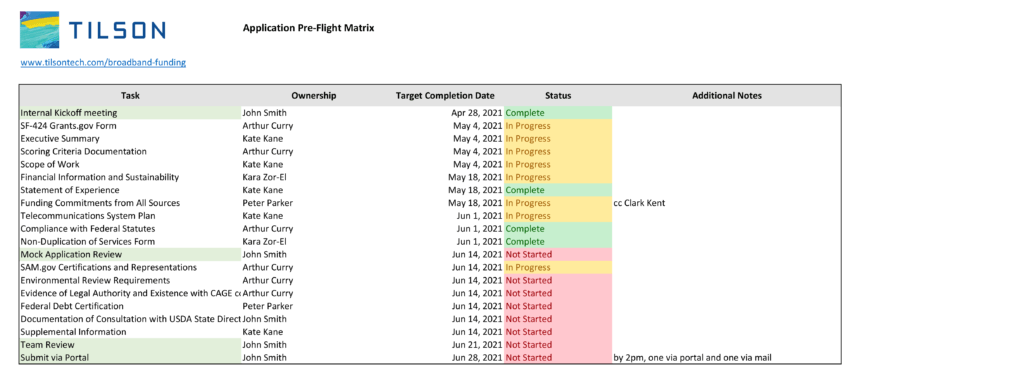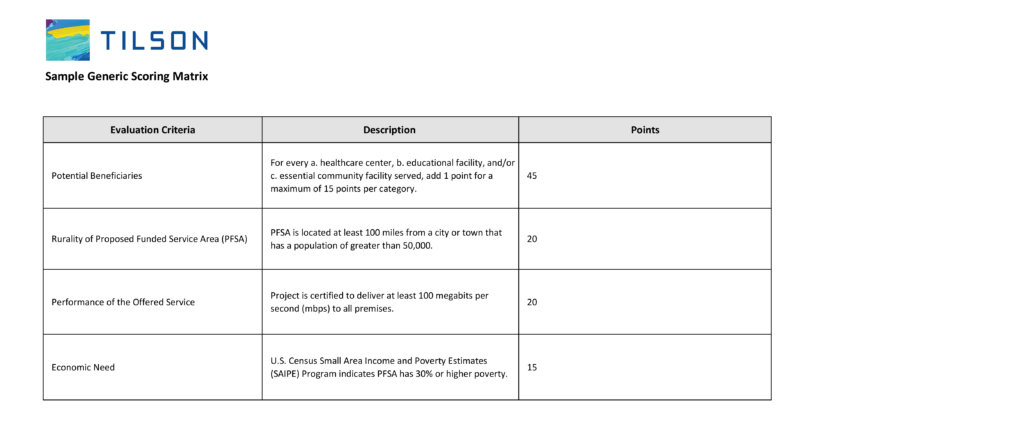In this latest installment of Tilson’s broadband blog series, “Are You Shovel-Ready?”, Tilson’s VP of Strategy and Business Development Andy Spurgeon uses his experience from NTIA’s Broadband Technology Opportunities Program, which funded more than $3B in broadband programs, to outline how to write a strong application for broadband funding.
Tilson plans, designs, builds, and maintains sustainable and cost-effective broadband networks essential to the health, safety, and quality of life in the modern community. Learn more about our comprehensive broadband deployment services or contact us to discuss your specific broadband goals.
//
In our previous article, we outlined the key planning considerations during both the application phase (to win funding) and the implementation phase (to make your project successful and sustainable long-term). We concentrated on the fundamentals of a designing a broadband program that aligns with strategically-selected funding sources based on the goals and objectives of your initiative.
In this article, we shift our focus to memorializing these important planning efforts in a strong, targeted, and well-supported funding application. You have done the legwork to plan and structure a winning program, and we must now demonstrate the strength of your project and encourage investment!
Grant applications vary greatly in almost every way including length, complexity, requirements, timeframe, and scoring methodology. This article attempts to provide some general best practices to keep front-of-mind when drafting your application, as well as call out some common mistakes to avoid.
In our two previous articles (“How to Assess Funding Opportunities” and “How to Plan a Winning Broadband Program”), we describe the important preparatory work that will lay a strong foundation for your project. You should already have a firm concept of your proposed project as you enter the application process, allowing you to focus on drafting a strong response rather than scrambling to meet funding requirements. If you don’t yet have a partner to help you assess funding opportunities and plan your broadband program, contact me at aspurgeon@tilsontech.com.
This may seem obvious, but it is important to sketch out your response’s structure and ensure that you understand all requirements before sitting down to write. This outline prevents rework and allows you to approach the task within the proper context. At Tilson, we make a practice of itemizing key elements and requirements into a checklist that we can refer to throughout the drafting process and use as a final pre-flight check before submission.
Download a Sample Copy of an Application Pre-Flight Checklist

Generally, competitive funding opportunities provide information on their scoring methodology, which will dictate prioritization and relative value of application components. You, of course, will want your entire application to shine, but understanding the weight assigned to each evaluation factor and tracing these factors to your outline will give you very important context as you draft your application. As you may suspect, more time and effort should be devoted to areas that carry more value.
You can also put your application through a test run. At Tilson, we create a mock selection committee about midway through the process who scores a draft of our application, providing important insights on how we can improve.
Download a Sample Generic Scoring Matrix

It is critical that your application articulates the greater impact and public benefits of your project. These benefits need to align with the funder’s objectives. Leverage all available supporting data, studies, and due diligence that has been undertaken to show the funding entity and its reviewers that the project will address common goals in a cost-effective, impactful, and sustainable manner. Feasibility studies, high-level designs, business plans, capital and operating expense estimations, and financial projections are all strong supporting material here. Tilson’s consulting team is highly experienced in undertaking these planning activities with a strong track record of success.
Determine the overarching theme or intention of the funding opportunity – What’s the problem? What’s the solution? – and address the theme throughout the application whenever possible, whether in narrative form or otherwise. While your project likely has beneficiaries and positive impacts beyond those targeted by the funding opportunity, highlighting how your project addresses the funding’s core objectives will resonate strongest (and therefore score the highest).
Developing a strong application takes more time than you might think. Setting a schedule upfront, with some flexibility and contingency time baked in, will help you stay on track and provide checkpoints to ensure your application is coming together properly. Make sure to incorporate plenty of review time to reduce the chances of something falling through the cracks or missing a deadline. In case of inclement weather, lost packages, or technical issues, always be prepared with a back-up delivery plan to make sure your application is submitted on time.
Most state and federal entities will incorporate your proposal into an award if you are successfully funded. That means that what you propose is what you win, and you must be prepared to execute. As a result, you should invest the time (and money) in the pre-application and application phase to ensure that you have a solid design, thorough budget and financial model, firm schedule, and strong partners. You will have limited opportunities to revise later.
Program planning and strategy are the foundational components that should inform and drive the application process, not the other way around. Funders, whether public or private, expect to see thoughtful approaches, well-defined projects, and supporting data. At Tilson, we put a heavy emphasis on making infrastructure projects “investment-ready” in the initial planning stages. This plan-first approach has a dual benefit of: a. developing actionable insights for strategic decision-making and b. generating strong documentation and data to support your project and attract investors.
Tilson designs, builds, and maintains sustainable and cost-effective broadband networks that are essential to the health, safety, and quality of life in the modern community. Learn more about our comprehensive broadband deployment services or contact us to discuss your specific broadband goals.

Andy Spurgeon is responsible for Tilson’s revenue generation strategy and business development activities. Previously, Andy served as Chief of Operations for broadband programs at the National Telecommunications & Information Administration (NTIA), with responsibilities spanning grant evaluation and oversight, data analytics, broadband technical assistance, and the implementation of the National Broadband Availability Map (NBAM).